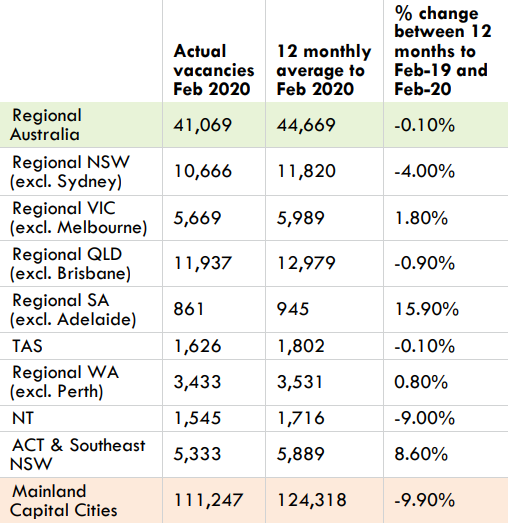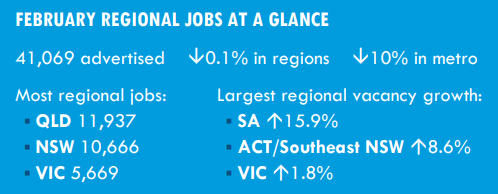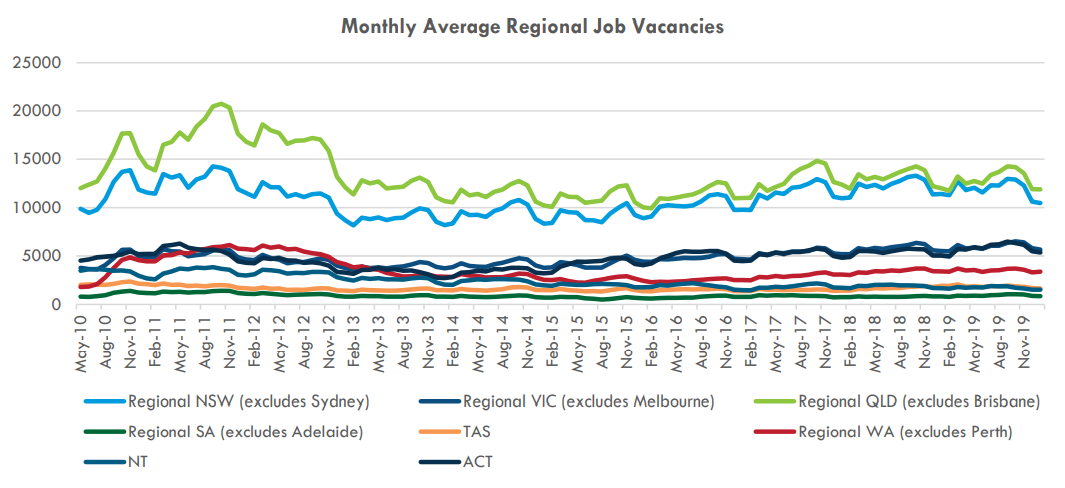By Chief Economist, Dr Kim Houghton
In February 2020 there were over 41,000 jobs advertised on the internet in regional Australia – outside the mainland state capitals. This shows that regional employers are still on the hunt for workers. The most in-demand skills are well paid, being mid to high skilled professionals and mid to high skilled trades jobs. The lifestyle benefits to people with these skills working in regional Australia are clear – good wages, low housing costs, great amenities, and no commuting problems.
The pattern of vacancies is similar across regional Australia in the need for skilled trades and professions. This means that regions are increasingly competing with each other for the same kinds of people – which is good for those with the skills, but hard on regions that aren’t on top of the desirability list. If businesses can’t get the workers they need, they can’t grow.
Looking over the whole 12 months to February, regional Australia as a whole saw a tiny 0.1% decrease in monthly average vacancies, while capital cities continued to slide with almost 10% fewer vacancies in the 12 months to February 2020 compared with the 12 months to February 2019. This is in line with gradual increases in unemployment rates.
The largest percentage growth in average monthly vacancies was in regional South Australia (up 15.9%), the ACT/Southeast NSW region (up 8.6%) and regional Victoria (up 1.8%).
Month-on month, February 2020 had fewer regional vacancies than February 2019. March and April figures will show us how employers have reacted to both the negative of the bushfires and COVID-19 and the positive of the return of good rain in many regions. Business confidence stepped up in February according to the Roy Morgan survey, while new job vacancy posts slipped from February to March.


The largest number of vacancies in February 2020 were in the regions with the largest populations: regional Queensland (11,937), regional New South Wales (10,666) and regional Victoria (5,669).
While COVID-19 is currently impacting the movement of people, ordinarily regional skilled vacancies will either be filled by locals training up, people moving from other parts of Australia or people coming from overseas. Skill levels are a critical part of the picture, and the vacancy data shows how important it is to improve the accessibility of post school education and training in regions. The Napthine report painted a picture of the changes needed, and the Regional University Centres program and expansion of VET places will help.
Attracting people from other parts of Australia relies on a perception of a great lifestyle and liveability – the social glue that holds our regional places together. A better distribution of population in Australia is being pursued through the National Population Strategy. Current regional vacancy trends show that the regions with the highest vacancy growth rates usually have the lowest population growth rates, highlighting the difficulties many inland regions are having in attracting and retaining the workers needed.
Attracting people from overseas means building on the incentives in our migration programs for migrants to study and work in regional Australia, both as their first stop, or as secondary migration out of the capital city that most settle in when they arrive.
Attracting people from other parts of Australia relies on a perception of a great lifestyle and liveability – the social glue that holds our regional places together.
NOTE: The Internet Vacancy data series is compiled by the Department of Employment, Skills, Small and Family Business. The Regional Australia Institute has developed a clickable map showing vacancies in the 37 regions: www.regionalaustralia.org.au/home/regional-jobs-vacancy-map
Download the Regional Jobs Update by Chief Economist, March 2020
